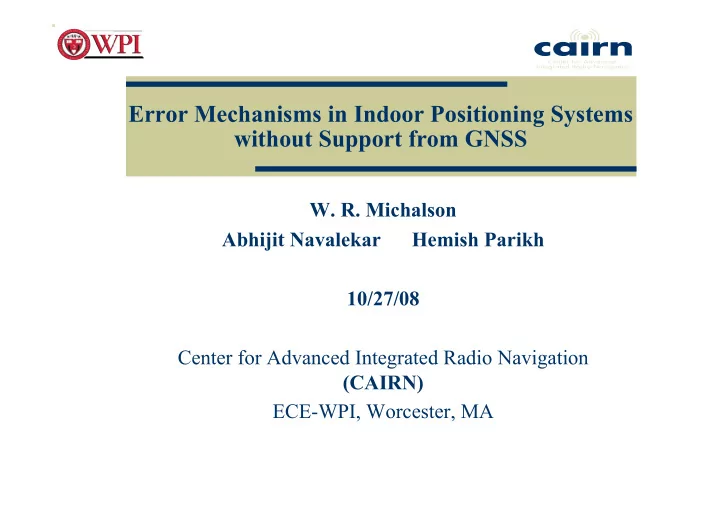

Error Mechanisms in Indoor Positioning Systems without Support from GNSS W. R. Michalson Abhijit Navalekar Hemish Parikh 10/27/08 Center for Advanced Integrated Radio Navigation (CAIRN) ECE-WPI, Worcester, MA
Outline • Introduction • Signal Structure • RF Prototype • NLOS Positioning Test Setup • NLOS Positioning Test Results • Error Sources • Conclusion 2
Introduction Personal Location and Navigation System The emergency vehicles and personnel carry an ad-hoc transceiver device The signals received on the receivers installed on the vehicles are used to calculate the relative position of the fire fighters in and around the building The location of the fire fighter is displayed at a command and control display 3
Signal Structure MC-UWB MC-UWB Signal: MC-UWB advantages: Robust in fading environment Improved spectral efficiency High data rate Simple signal generation 4
RF Prototype Custom MC-UWB RF Prototype Design Required 5
RF Prototype - Transmitter SSB Transmitter Output Frequency Range 550MHz – 698MHz (BW: 148MHz) Fractional Bandwidth: 24% 6
RF Prototype - Transmitter Transmitter Output = -10dBm/SC 7
RF Prototype - Transmitter Spurious Emissions at Transmitter Output: LO, LSB SSB Transmitter Architecture Spectral Mask Need very steep LPF and BPF ADS Simulations Sensitive to even 0.2pF Tuning Very Difficult 8
RF Prototype - Receiver System Parameter Achieved System G (dB) 50 System NF (dB) 4.5 Direct Downconversion Receiver Architecture System IIP3 (dBm) -19 Rx. Sensitivity (dBm) -87 Rx. SFDR (dB) 45.3 9
RF Prototype - Receiver Direct Downconversion Receiver Output Frequency Range 30MHz – 178MHz (BW: 148MHz) Fractional Bandwidth: 24% 10
NLOS Positioning Test Setup 148MHz RF System 148MHz RF System Transmitter Output Receiver Output 11
NLOS Positioning Test Setup Test Setup: 20mx20m brick building 1 Transmitter inside 16 Receiving antennas outside, covering 3 sides 12
NLOS Positioning Test Results Test Results: Min Error: 0.22m Max Error: 6.6m Mean Error: 2.84m 13
NLOS Positioning Error Sources 14
NLOS Positioning Error Sources Error Source Error (meter) Design Constraints / Comments Sampling CLK Shift 0.003 < 10 ppm: Sampling CLK frequency error Sampling CLKDrift 0.003 < 10 ppm: Sampling CLK frequency error Local Oscillator Shift 0.010 < 2.5 ppm: Local oscillator frequency error Local Oscillator Drift 0.010 < 2.5 ppm: Local oscillator frequency error Receiver Geometry 0.30 Optimum receiver geometry very important Antenna Type 0.30 Need to use directional antennas at receivers Software Processing 0.10 Optimum selection of the useful spectrum Path Loss / Shadow Fading 0.10 AGC implementation at the transmitter and receiver Narrowband Interference 0.30 Optimum selection of the useful spectrum NLOS 0.50 Better geometry, antenna, transmit power required Multipath 0.50 Need for channel models specific to indoor positioning Building Dielectric Properties ??? Characterize delays induced by various building materials Total RSS Error ??? 15
NLOS Positioning Error Sources No Multipath, Effect of Dielectric Properties Only Error = 0.93m Error = 3.48m 16
NLOS Positioning Error Sources Total Wall Thickness vs. Total Signal Delay / Total Error 17
NLOS Positioning Error Sources Error Source Error (meter) Design Constraints / Comments Sampling CLK Shift 0.003 < 10 ppm: Sampling CLK frequency error Sampling CLKDrift 0.003 < 10 ppm: Sampling CLK frequency error Local Oscillator Shift 0.010 < 2.5 ppm: Local oscillator frequency error Local Oscillator Drift 0.010 < 2.5 ppm: Local oscillator frequency error Receiver Geometry 0.30 Optimum receiver geometryVery important Antenna Type 0.30 Need to use directional antennas at receivers Software Processing 0.10 Optimum selection of the useful spectrum Path Loss / Shadow Fading 0.10 AGC implementation at the transmitter and receiver Narrowband Interference 0.30 Optimum selection of the useful spectrum NLOS 0.50 Better geometry, antenna,transmit power required Multipath 0.50 Need for channel modelsspecific to indoor positioning Building Dielectric Properties > 0.5 Characterize delays induced by various building materials Total RSS Error > 2.626 18
NLOS Positioning Error Individual Error Contributions 19
Conclusion - Dielectric properties of the building materials add to the positioning error. - The indoor environment typically has more than two walls and this could lead to indoor positioning errors of the order of 2 to 3m. - This not so well characterized source of error needs to be considered independently in indoor positioning systems - There is a need to calibrate the positioning system thus minimizing the errors due to building dielectric material properties 20
????? 21
Recommend
More recommend